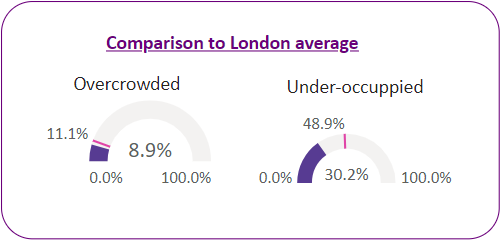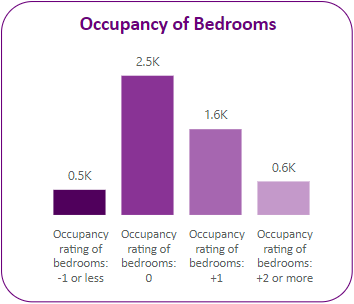Legal partnership status
2 in 5 residents (43%) aged 16+ are living as a couple (43% in H&F and 50% in London).
The ward has a similar proportion (43%) of residents who are single-never married as H&F (44%). Slightly fewer residents are married (28%) compared to the borough average of 29%.
Housing
5,137
total dwellings
86%
are flats or maisonettes
26%
are 1-bed properties
47%
are 2-bed properties
£912k
Average price of dwellings
In 2021 there were 5,137 dwellings in the ward and less than 1% of dwellings were shared between 2 or more households.
The housing stock is characterised by a large proportion of flats and maisonettes (86%), the 4th highest among all wards in H&F.
26% of all properties have 1 bedroom (ranked 5th lowest) and 47% have 2 bedrooms (ranked the highest).
The average price of dwellings in the ward is £912,209 compared with £726k in the borough and £584k in London.
Household tenure
The owner-occupied sector is the largest tenure and accounts for 36% of all households (32% in 2011), compared to 34% in the borough as a whole. 35% of households rent their home from a private landlord (29% in 2011) compared to 36% in H&F.
29% rent their home from a social housing provider (35% in 2011), compared to 30% in H&F. 11% rent from the council (ranked 9th lowest), and 18% from housing associations (ranked 6th highest).

Occupany levels

The proportion of households identified as living in overcrowded homes (have 1 fewer bedroom than required) is 9% (455 households) which is lower than the borough average (11% in London).
30% of households are under-occupied by 1 bedroom and a further 12% by 2 or more bedrooms (42% in total). This compares to 43% in H&F and 49% in London. Under occupancy means there are more bedrooms than required.

Occupancy is calculated by comparing the number of bedrooms the household requires to the number of available bedrooms based on the bedroom standard. Occupancy rating for bedrooms variable: Census 2021 - ONS.GOV.UK
In Sands End ward:
- 500 households have 1 fewer bedroom than required
- 2,500 households have the right number of bedrooms required
- 1,600 households have 1 bedroom more than required
- 600 households have 2 bedrooms more than required
Figures have been rounded to the nearest hundred.